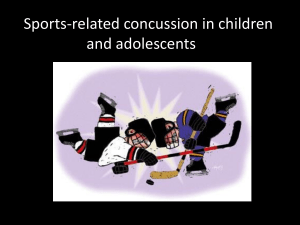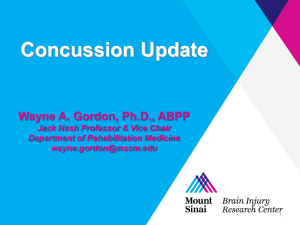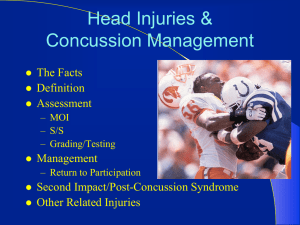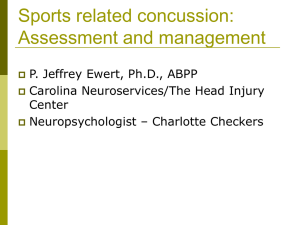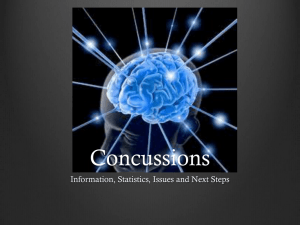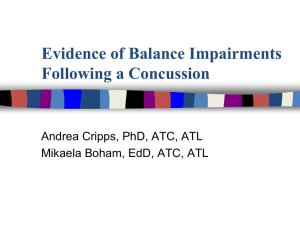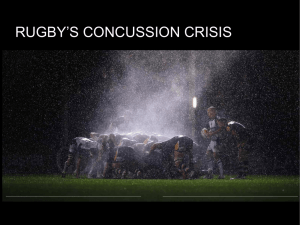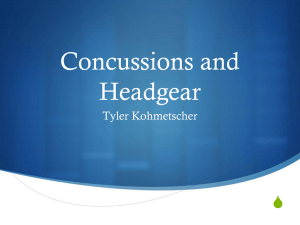View the Concussion presentation
advertisement
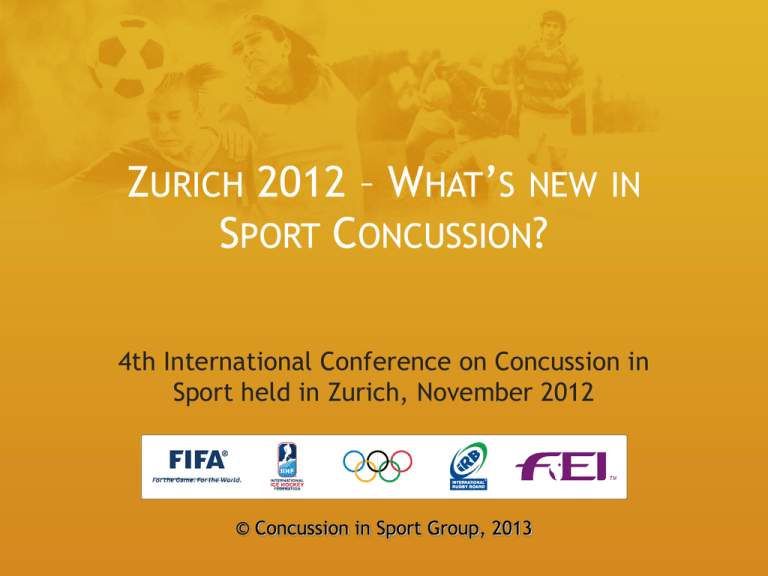
ZURICH 2012 – WHAT’S NEW IN SPORT CONCUSSION? 4th International Conference on Concussion in Sport held in Zurich, November 2012 © Concussion in Sport Group, 2013 OUTLINE 1. 2. 3. 4. 5. 6. 7. 8. Process Definitions Evaluation Management Modifying Factors Special Populations Other Issues SCAT3, CRT, child SCAT3 1. PROCESS • 1st Vienna 2001, 2nd Prague 2004, 3rd Zurich 2008 • 4th meeting in Zurich 2012 • NIH consensus development conference format • • • • • • Pre-defined group of questions Body of literature identified Presentation by experts in open session day 1 and day 2 Discussion / debate closed session with consensus panel on day 3 Document drafted by authors and circulated to panel Knowledge translation EXPERT PANEL • Identified for expertise and commitment to: • • • • • • Author critical review papers (start April 2012) Read all evidence prior to consensus meeting Review all research abstracts at meeting Attend all open lectures Participate in closed panel discussion Review and approve final consensus statement ZURICH 2012 CONSENSUS QUESTIONS 1. What is the lowest threshold to make a diagnosis of concussion? 2. Are the existing tools/exam sensitive and reliable enough on the day of injury to make or exclude a diagnosis of concussion? 3. What is the best practice for evaluating an adult athlete on the "field of play" in 2012? 4. How can the SCAT2 be improved?: evidence for utility of components 5. What evidence exits for new strategies/technologies in the diagnosis of concussion and assessment of recovery? ZURICH 2012 CONSENSUS QUESTIONS 6. Advances in the management of sport concussion: what is evidence for concussion therapies? 7. The difficult concussion patient - What is the best approach to investigation and management of persistent (>10 days) post concussive symptoms? 8. Revisiting Modifiers: how should the evaluation and management of acute concussion differ in specific groups? 9. What are the most effective risk reduction strategies in sport concussion?: from protective equipment to policy 10. What is the evidence for chronic concussion-related changes?; behavioral, pathological and clinical outcomes 11. From Consensus to Action- How do we optimize Knowledge transfer, education and ability to influence policy? Expert Panel Members Scientific Committee: • • • • • • • • • • • Paul McCrory Willem Meeuwisse Mark Aubry Robert Cantu Jiri Dvorak Ruben Echemendia Lars Engebretsen Karen Johnston Jeffrey Kutcher Martin Raftery Allen Sills Additional Panelists (alphabetical order) •Brian Benson •Gavin Davis •Richard Ellenbogen •Kevin Guskiewicz •Stan Herring •Grant Iverson •Barry Jordan •James Kissick •Michael Makdissi •Michael McCrea •Amdrew McIntosh •David Maddocks •Laura Purcell •Margot Putukian •Kathryn Schneider •Charles Tator •Michael Turner OUTPUTS: Co-publication multiple journals 2013 including: • BJSM • with critical reviews • • • • • • • • CJSM J. Athletic Tr J. Clin Neurosci J. Sci & Med in Sport PM&R Scand J Sci Med Sport S. African J. of Sport Med J. Amer College of Surgeons OUTPUTS OUTPUTS All lectures on line • www.f-marc.com Free download of Statement & Tools • bjsm.bmj.com • www.cjsportmed.com Powerpoint presentation 2. DEFINITIONS TRAUMATIC BRAIN INJURY Glasgow Coma Scale “Minimal” Mild Mod Severe ? Sports concussion Severe GCS ≤ 8 Moderate GCS 9 - 12 Mild GCS 13 - 15 Teasdale et al Lancet 1974; ii: 81-4 INJURY DEFINITION: SPORTS CONCUSSION “Concussion is a brain injury and is defined as a complex pathophysiological process affecting the brain, induced by biomechanical forces. Several common features that incorporate clinical, pathologic and biomechanical injury constructs that may be utilized in defining the nature of a concussive head injury include…” DEFINITION 1. 2. 3. 4. Concussion may be caused either by a direct blow to the head, face, neck or elsewhere on the body with an ‘‘impulsive’’ force transmitted to the head. Concussion typically results in the rapid onset of short- lived impairment of neurologic function that resolves spontaneously. However in some cases symptoms and signs may evolve over a number of minutes to hours. Concussion may result in neuropathological changes but the acute clinical symptoms largely reflect a functional disturbance rather than a structural injury and as such, no abnormality is seen on standard structural neuroimaging studies. Concussion results in a graded set of clinical symptoms that may or may not involve loss of consciousness. Resolution of the clinical and cognitive symptoms typically follows a sequential course. However it is important to note that in some cases, post-concussive symptoms may be prolonged. 3. EVALUATION SIGNS AND SYMPTOMS • Symptoms - somatic (e.g. headache), cognitive (e.g. feeling like in a fog) and/or emotional symptoms (e.g. lability) • Physical signs (e.g. loss of consciousness, amnesia) • Behavioural changes (e.g. irritability) • Cognitive impairment (e.g. slowed reaction times) • Sleep disturbance (e.g. drowsiness, insomnia) ON-FIELD OR SIDELINE EVALUATION OF ACUTE CONCUSSION-WHEN A PLAYER SHOWS ANY FEATURES OF A CONCUSSION • • • • • The player should be evaluated by a physician or other licensed healthcare provider onsite using standard emergency management principles and particular attention should be given to excluding a cervical spine injury. The appropriate disposition of the player must be determined by the treating healthcare provider in a timely manner. If no healthcare provider is available the player should be safely removed from practice or play and urgent referral to a physician arranged. Once the first aid issues are addressed an assessment of the concussive injury should be made using the SCAT3 or other sideline assessment tools. The player should not be left alone following the injury and serial monitoring for deterioration is essential over the initial few hours following injury. A player with diagnosed concussion should not be allowed to return to play on the day of injury. DETAILED CLINICAL ASSESSMENT OUTLINED IN SCAT3 AND CHILD SCAT3 NOTE: Developed by SCAT3 Subcommittee (Meeuwisse, McCrory, Dvorak, Echemendia, Guskiewicz Iverson, Johnston, McCrea, Putukian, Raftery, Schneider) EVALUATION IN EMERGENCY ROOM OR OFFICE BY MEDICAL PERSONNEL • • • • Individual clinical decision A medical assessment including a comprehensive history and detailed neurological examination including a thorough assessment of mental status, cognitive functioning and gait and balance. A determination of the clinical status of the patient including whether there has been improvement or deterioration since the time of injury. This may involve seeking additional information from parents, coaches, teammates and eyewitness to the injury. A determination of the need for emergent neuroimaging in order to exclude a more severe brain injury involving a structural abnormality In large part, these points above are included in the SCAT3 assessment INVESTIGATIONS • Neuroimaging (CT, MRI) • Contributes little to concussion evaluation • Use when suspicion of intracerebral or structural lesion exists: • focal neurologic deficit • worsening symptoms • Prolonged disturbance of conscious state • Other modalities such as fMRI correlate with symptom severity and recovery and although not routinely used presently may provide additional insight. • Alternative imaging technologies are still at early stage of development in concussion and not recommended other than research setting INVESTIGATIONS • Postural stability testing-deficits 72hr post concussion • Balance error scoring system (BESS), force plate technology • Genetic testing/markers • Significance unclear for Apolipoprotein (Apo) E4, ApoE promoter gene, Tau polymerase, other genetic and cytokine factors • Insufficient evidence for routine clinical use INVESTIGATIONS Neuropsychological (NP) assessment: • Important component in overall assessment and RTP • Should NOT be sole basis of management decisions, but an aid to clinical decision making • Included as part of clinical neurological assessment by treating physician often with computerized NP screening tools • Formal NP testing not required for all but, if so, interpretation should be performed by trained neuropsychologist. • Best done when asymptomatic but may be advantageous at other stages in particular situations • Baseline testing not mandatory. May be helpful in test interpretation and for education opportunity 4. MANAGEMENT RECOVERY • Majority (80-90%) resolve in short (7-10 day) period • May take longer in children and adolescents MANAGEMENT • CORNERSTONE = initial period of rest until acute symptoms resolve Physical Rest No training, playing, exercise, weights Beware of exertion with activities of daily living Cognitive Rest No television, extensive reading, video games? Caution re: daytime sleep MANAGEMENT • Expect gradual resolution within 7-10 days • Gradual return to school and social activities that does not result in significant exacerbation of symptoms • Proceed through step-wise return to sport / play (RTP) strategy RECOVERED? • • Everyone “feels fine” Always ask: 1.“On a scale of 0 to 100%, how do you feel?” 2.“what makes you not 100%?” 3. Symptom Checklist – SCAT3 GRADUATED RTP PROTOCOL Rehabilitation stage Functional exercise at each stage of rehabilitation Objective of each stage 1. No activity Symptom limited physical and cognitive rest. Recovery 2.Light aerobic exercise Walking, swimming or stationary cycling keeping intensity < 70% MPHR No resistance training. Increase HR 3.Sport-specific exercise Skating drills in ice hockey, running drills in soccer. No head impact activities. Add movement 4.Non-contact training drills Progression to more complex training drills e.g. passing drills in football and ice hockey. May start progressive resistance training Exercise, coordination, and cognitive load 5.Full contact practice Following medical clearance participate in normal training activities Restore confidence and assess functional skills by coaching staff 6.Return to play Normal game play • 24 hours per step (therefore about 1 week for full protocol) • If recurrence of symptoms at any stage, return to previous asymptomatic level and resume after further 24 hr period of rest SAME DAY RETURN TO PLAY? • NO! • Unanimously agreed that no RTP should occur on the day of concussive injury RETURN TO PLAY / SPORT • Must pass graded exertion first =remain asymptomatic • Is the athlete confident to go back? • New helmet/head gear? • Other “protective” equipment / behaviors / factors? • Consider implications of multiple/recent injury “DIFFICULT” OR PERSISTENTLY SYMPTOMATIC CONCUSSION PATIENT • Persistent symptoms (>10 days) in about 10-15% • Important to consider other issues • Should be managed in multidisciplinary manner by healthcare providers experienced in sport concussion • In order to consider sub-symptom threshold exercise and other forms of therapy /rehabilitation PSYCHOLOGICAL & MENTAL HEALTH ISSUES • Psychological approaches may have application especially in selected situations (modifiers) • Evaluate for affective symptoms (depression, anxiety) as common in all forms of traumatic brain injury • Depression-may be consequence of concussion, underlying pathophysiological abnormality, may be multifactorial but should be considered in management MANAGEMENT • Pharmacotherapy Prolonged symptoms (sleep disturbance, anxiety) Modify underlying pathophysiology • Upon return to play should not be on medication that could mask symptoms Antidepressants? 5. MODIFYING FACTORS FACTORS MODIFIER Symptoms Number Duration (>10 days) Severity Signs Prolonged LOC (>1min) Amnesia Sequelae Concussive convulsions Temporal Frequency –repeated concussion over time Timing – injuries close together “Recency” – recent concussion or TBI Threshold Repeated concussions occurring with progressively less impact force or slower recovery after each successive concussion Age Child and adolescent (< 18 years old) Co and Pre-morbidities Migraine, depression or other mental health disorders, attention deficit hyperactivity disorder (ADHD), learning disabilities (LD), sleep disorders Medication Psychoactive drugs Anticoagulants Behaviour Dangerous style of play Sport High risk activity Contact and collision sport High sporting level MODIFIERS • May influence investigation and management • May predict potential for prolonged or persistent symptoms • Multidisciplinary approach coordinated by a physician with specific expertise in management of concussion. 6. SPECIAL POPULATIONS CHILD AND ADOLESCENT ATHLETE • Adult recommendations can apply down to age 13 • Below 13 require age appropriate symptom checklists and evaluation tool • child SCAT3 developed for this purpose • Include both patient and parent, teacher, school input. • Possibly use neuropsychological testing before symptoms resolve to help plan school management • must be developmentally sensitive, consider use of trained pediatric neuropsychologist NOTE: Pediatric subcommittee has developed age-specific Child SCAT3 (Davis, McCrea, G. Gioia, Purcell, Ellenbogen, C. Vaughan, Guskiewicz, Kutcher, Meeuwisse, McCrory) CHILD AND ADOLESCENT ATHLETE • Consider age specific physical and cognitive rest issues • school attendance and activities need to be modified • No return to sport or activity until returned to school successfully • Symptom resolution may take longer, modifiers apply even more • More conservative RTP approach recommended: • Consider extending symptom-free period before starting return to play protocol • Consider extending length of the graded exertion protocol • Never return to play same day ELITE VS NON-ELITE • All athletes should be managed the same regardless of level of participation • Available resources and expertise may determine management approaches • Consider cognitive evaluation in all organized high-risk sports regardless of age or level of performance 7. OTHER ISSUES CHRONIC TRAUMATIC ENCEPHALOPATHY (CTE) • Acknowledge potential for long-term problems in all athletes • CTE unknown incidence in athletic populations, cause/effect not yet demonstrated between CTE and concussions or exposure to contact sport PREVENTION • Protective equipment • Mouthguards have benefit in prevention oral injury, but no evidence of concussion reduction • Head gear and helmets show reduction in biomechanical forces, but have not translated to a reduction in concussion incidence • Helmets reduce head and facial injury in skiing and snowboarding and are recommended for alpine sports • Helmets reduce other forms of head injury (e.g. fracture) in cycling, equestrian, motor sports OTHER ISSUES • Rule changes • Consider where clear cut mechanism is implicated • To allow for effective off-field medical assessment (time and proper environment) • Risk compensation • Use of protective equipment may change behavior-especially child and adolescent • Aggression vs violence • Violent behavior that increases concussion risk should be eliminated • Promote fair play and respect PREPARTICIPATION EVALUATION • History: • Type of sport? • Previous symptoms of concussions?/length of recovery (recall unreliable from teammates, coaches) • Prior head, maxillofacial, spine injuries? • Non-sporting head injuries? • Type of player (“physical”?) • Ability to “take a hit” • Protective equipment (helmet age) • Opportunity to Educate! KNOWLEDGE TRANSFER • Education of athletes, parents, coaches • Awareness of concussion symptoms and signs • Fair play and respect • Role for web based resources, social media SUMMARY: WHAT’S NEW? • • • • • • Evaluation on the “field of play” Postural stability assessment Timing of “rehabilitation” The difficult concussion patient Special populations New Tools • Sport Concussion Assessment Tool revision (SCAT3) • Child SCAT3 • Concussion Recognition Tool (CRT) for lay use Consensus Statement on Concussion in Sport THANK YOU! 4th International Conference on Concussion in Sport held in Zurich, November 2012 © Concussion in Sport Group, 2013 SPORT CONCUSSION ASSESSMENT TOOL 3RD EDITION SCAT3 SCAT3 – 4 PAGE LAYOUT 4. Patient Information 2. Scoring 3. Instructions 1. Sideline Assessment CHILD SPORT CONCUSSION ASSESSMENT TOOL CHILD SCAT3 CHILD SCAT3 -DIFFERENCES • Child Maddocks questions • Symptom Scale child-specific • 4 point rating scale • Parent rating of child’s symptoms • Orientation • no time of day • Concentration • start with 2 reverse digits • Reverse days of the week • Modified BESS • no single leg stance • Patient advice • return to school POCKET CONCUSSION RECOGNITION TOOL POCKET CRT POCKET CRT Consensus Statement on Concussion in Sport THANK YOU! 4th International Conference on Concussion in Sport held in Zurich, November 2012 © Concussion in Sport Group, 2013

